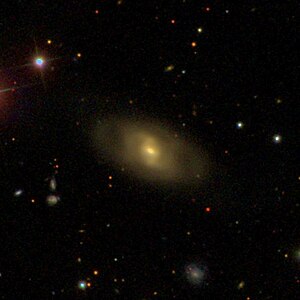NGC 2553
| Galaxy NGC 2553 |
|
|---|---|

|
|
| SDSS recording | |
| AladinLite | |
| Constellation | cancer |
|
Position equinox : J2000.0 , epoch : J2000.0 |
|
| Right ascension | 08 h 17 m 35.0 s |
| declination | + 20 ° 54 ′ 11 ″ |
| Appearance | |
| Morphological type | S0 |
| Brightness (visual) | 14.1 mag |
| Brightness (B-band) | 14.9 mag |
| Angular expansion | 1.7 ′ × 0.8 ′ |
| Position angle | 72 ° |
| Surface brightness | 14.3 mag / arcmin² |
| Physical data | |
| Affiliation | NGC 2563 group |
| Redshift | 0.015748 ± 0.000073 |
| Radial velocity | 4721 ± 22 km / s |
|
Stroke distance v rad / H 0 |
(207 ± 15) · 10 6 ly (63.5 ± 4.5) Mpc |
| history | |
| discovery | Albert Marth |
| Discovery date | February 17, 1865 |
| Catalog names | |
| NGC 2553 • PGC 23240 • CGCG 119-031 • MCG + 04-20-014 • 2MASX J08173503 + 2054116 • GALEX ASC J081734.93 + 205408.9 • LDCE 571 NED002 | |
NGC 2553 is a lenticular galaxy of Hubble type S0 in the constellation Cancer on the ecliptic . It is an estimated 207 million light years away from the Milky Way and is approximately 105,000 light years in diameter.
In the same area of the sky are the galaxies NGC 2556 , NGC 2558 , NGC 2560 , IC 2253 .
The object was discovered by Albert Marth on February 17, 1865 .
